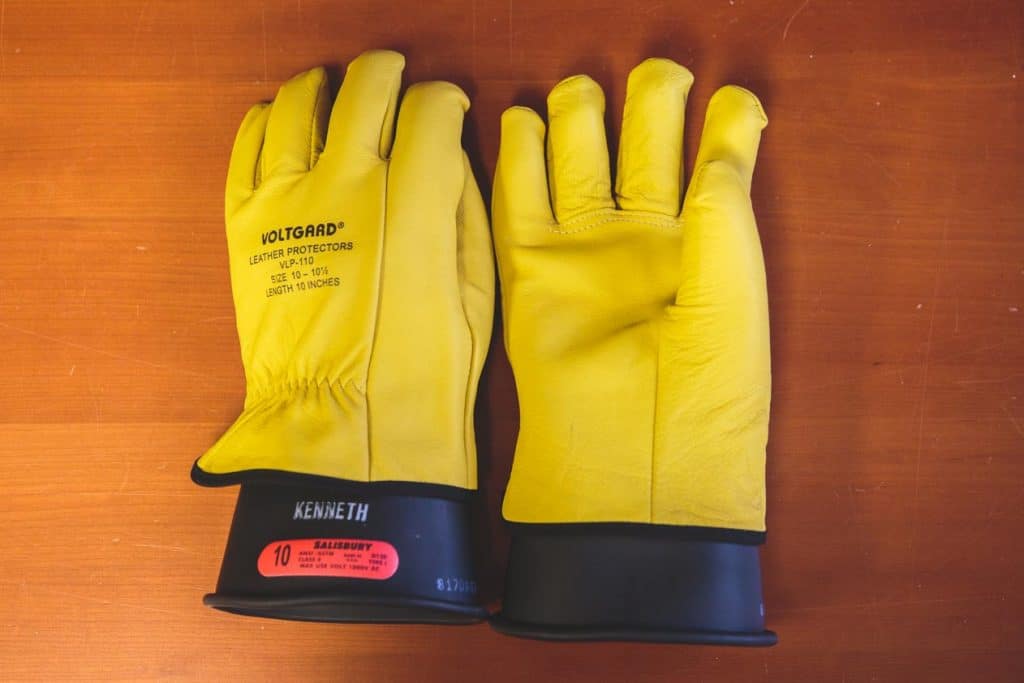Why Do I Have to Wear Gloves?
A journeyman lineman was fortunate as he was working on energized equipment with a hot stick. An arc flash occurred, and he received burns to the knuckles on one hand. After a medical examination, he was given the all clear.
Some electricians do not like to wear gloves because gloves can hamper the task assigned to them. Firefighters face the same challenge, having to learn hose-handling and life safety rope knot-tying while wearing gloves. It can certainly be challenging, but the alternative can lead to hand burns, and in the case of electrical workers, internal burns from electrical shock, and/or external burn from arc flash.
Mission: Electric Safety
May is National Electric Safety Month. This national awareness campaign is spearheaded by the Electrical Safety Foundation International (ESFI), a non-profit organization that dedicates its time and resources to promoting electrical safety at home and in the workplace.
Like ESFI, e-Hazard has a mission to reduce electrically-related injuries and deaths. e-Hazard has a variety of electrical safety training classes that emphasize electrical issues that affect workers in commercial and industrial settings, as well as utilities. While our safety classes do not focus on residential jobs, we understand that training someone at work will also influence to some extent safety choices one makes at home.
NFPA and OSHA
NFPA 70E gives guidance on proper PPE for electrical workers in industrial and commercial settings. The only time an electrician can have his or her hands in a panel or around electrical equipment is when there is zero energy going to the equipment – which has to be locked out/tagged out and verified. Otherwise, voltage-rated gloves must be worn according to the voltage at which the equipment is rated.
Utility workers coming under OSHA 1910.269 have similar requirements when exposed to shock and arc flash hazards. e-Hazard always recommends electrical gloves, even when using hot sticks, to prevent any chance of electrical shocks or arc-related burns. Electrical utility cultures in different parts of the United States seem to follow different rules when it comes to wearing gloves while using hot sticks. Since these tools are considered primary insulation, technically speaking, no further shock protection is required. However, OSHA does require protection from the hazards of arcing energy while performing electrical work.
While hot sticks can be primary protection (many western utilities in the US allow this), we recommend using rubber insulating gloves with protectors or AR gloves for working with hotsticks to address the arc hazard. Many lineworkers from the Western US will argue that they can “feel” the stick breaking down. While this could be true, the difference between “feeling” electricity and “dying” from electricity is just a few milli-amps. The arc flash AND shock hazards must be addressed.
Don’t forget to have the rubber insulating gloves dielectrically tested regularly – every six months, according to NFPA 70E Table 130.7(C)(7)(c).
Where to Test Gloves
Check out the North American Independent Laboratories website for accredited labs.
For more training on electrical and arc flash safety and hazard analysis, visit our website.


I’m a inspector that needs to look at and open electric service panels, what do you recommend for ppe.
IAEI would recommend you follow NFPA 70E. At the minimum, you should be in AR garment of about 8 cal/cm2 for anything 3-Phase but in some cases you would want a 40 cal or better suit.
I would recommend attending a class like the e-Hazard.com training on NFPA 70E. The PPE risk tables are the best you can do if the panels aren’t labeled. Most lives are saved if the clothing doesn’t ignite or AR is a MUST.
Good luck and let us know if we can help.
questions@e-hazard.com
Do the gloves have to match the voltage when using hot sticks for switching or can they be a lower voltage class? What do you recommend for 69kV and 115kV switching? Thanks!
Clarissa, the article is referring specifically to arc rated gloves, which are typically worn as protectors over a proper voltage-rated glove for the task at hand. Class IV gloves are rated for a maximum of 36kV RMS, and there are no glove ratings for the levels you mention. This is when we incorporate alternate methods in accordance with US OSHA 1910.269 to prevent shock, including creation of an equalized potential zone. For hot stick operations, a live-line tool that has been properly tested in the last 24 months and properly pre-inspected and cleaned serves as a primary protector and often is used without voltage-rated gloves. If you need more information, please contact me at ken.sellars@e-hazard.com.